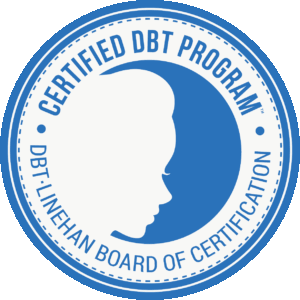Are you feeling overwhelmed by your emotions, struggling with your relationships, and seeking answers that traditional methods have failed to provide? If so, you’re not alone. The choice between Cognitive Behavioral Therapy (CBT) and Dialectical Behavioral Therapy (DBT) can be bewildering, particularly when you’re grappling with deep-seated concerns like emotional regulation, self-harm, or suicidal thoughts. But at ‘DBT of South Jersey‘, we believe in simplifying this choice so you can embark on a healing journey that meets your unique needs.
CBT and DBT, while fundamentally rooted in talk therapy, approach the mind’s workings from vastly differing perspectives. CBT, a short-term goal-oriented therapy, focuses on solving present issues by modifying negative thoughts and behaviors, thus offering quick relief in specific problematic areas. On the other hand, DBT engenders a balanced perspective by embracing acceptance and change, honing on emotional and social aspects, and primarily assisting with behavioral skills. Essentially, making the choice relies on understanding these two therapeutic approaches in depth, exploring their similarities and differences, and aligning them with your distinct requirements.
To facilitate your decision-making, ponder upon these quick comparisons:
- Focus: CBT concentrates on specific issues and behaviors, whereas DBT centers on emotional regulation and interpersonal effectiveness.
- Goals: CBT aims for problem-specific solutions by changing negative thoughts and actions, while DBT seeks acceptance, emotional balance, and behavior regulation.
- Sessions: In CBT, discussions revolve around your immediate concerns, but DBT includes both individual therapy and group sessions to practice behavioral skills.

In the forthcoming sections, we delve into these therapy methods, their principles, processes, and applicability conditions. Our ultimate goal? To empower you in making an informed choice between DBT or CBT – a choice that could potentially steer your life toward a healthier, happier horizon. Let’s embark on this enlightening journey together.
Understanding Cognitive Behavioral Therapy (CBT)
Cognitive Behavioral Therapy (CBT) is a widely recognized and evidence-based psychotherapy form. It operates on the principle that our thoughts, and the beliefs we derive from them, have a significant influence on our behavior and emotions. CBT focuses on identifying and altering these maladaptive thought processes and behaviors to promote healthier thinking and actions.
The Principles of CBT
The primary principle of CBT is that our thoughts directly influence our beliefs, which in turn, shape our behavior and emotions. For instance, if you think others judge or dislike you, you might avoid social situations, leading to feelings of loneliness. CBT aims to modify these unwanted behaviors by identifying, addressing, and changing problematic or irrational thoughts.
As part of the therapeutic process, participants learn to reevaluate negative thought processes, calm their mind and body, confront fears instead of avoiding them, develop healthy coping skills, and build self-confidence and self-esteem.
The Process of CBT
CBT is typically a structured, short-term treatment spanning around 10 to 16 sessions. It’s goal-oriented and focuses on the present. The process includes education and discussion about the condition, how it affects the individual, and the treatment process.
Participants learn and practice skills like problem-solving and realistic thinking to change problematic thoughts, feelings, and behaviors. Through this, they learn how to apply these skills to future problems.
CBT can be administered in various settings, including face-to-face or virtually, making it accessible and adaptable to different needs and situations.
Conditions Treated with CBT
CBT is employed to treat a wide variety of mental health conditions and symptoms. It’s been found effective in treating depression, anxiety, post-traumatic stress disorder (PTSD), phobias, and substance-use disorders.
CBT can be modified and tailored to specific purposes or situations. For instance, CBT for depression may employ different techniques than CBT for eating disorders, even though they’re based on the same principles.
In conclusion, understanding the principles, process, and applicability conditions of Cognitive Behavioral Therapy can help you decide if this approach aligns with your needs. In the next section, we’ll shift gears to explore the nuances of Dialectical Behavioral Therapy (DBT), another highly effective therapy approach. Stay tuned as we delve deeper into DBT therapy vs. CBT therapy.
Understanding Dialectical Behavior Therapy (DBT)
DBT, or Dialectical Behavior Therapy, is a type of therapy developed by Dr. Marsha Linehan. Initially, DBT was designed as a treatment for individuals with borderline personality disorder (BPD) who displayed strong self-destructive behaviors or suicidal ideation.
The Principles of DBT
DBT is grounded on a cognitive-behavioral theoretical framework, similar to CBT, but it also introduces new elements like acceptance, dialectics, and validation. DBT emphasizes that everything is interconnected, change is constant and inevitable, and seemingly opposing viewpoints can be integrated.
One essential concept in DBT is ‘radical acceptance,’ which means accepting that negative experiences may occur, but you have the tools to manage them. This principle helps individuals understand that pain and stress are part of life and encourages them to cultivate resilience by learning effective coping mechanisms.
The Process of DBT
DBT is a structured form of therapy that typically consists of four stages, each addressing different aspects of the individual’s life.
- Stage 1 aims to stabilize the person, decrease behaviors that interfere with life and therapy, and replace dysfunctional behaviors with skillful ones.
- Stage 2 is about helping the person experience a full range of emotions and reducing emotional distress.
- Stage 3 addresses ordinary life problems, and
- Stage 4 is about reaching the highest level of functioning and achieving a sense of completeness.
DBT can be delivered through various modes, including skills training groups, individual psychotherapy, and telephone consultation. The skills training group is a crucial component of DBT, where individuals learn mindfulness, distress tolerance, interpersonal effectiveness, and emotion regulation skills.
Conditions Treated with DBT
While initially designed for individuals with BPD, DBT has since proved effective for treating a wide variety of mental health disorders. These include mood disorders, substance-use disorders, eating disorders, and post-traumatic stress disorder (PTSD).
At DBT of South Jersey, we focus on addressing your symptoms, regardless of the diagnosis. We believe that given all experiences leading up to now, everything makes sense. DBT can be a powerful tool for those struggling with emotional regulation, self-destructive behaviors, and unstable relationships.
Stay with us as we delve further into the comparison of DBT therapy vs. CBT therapy, helping you understand which approach may be right for you.
Comparing CBT and DBT
As we of DBT of South Jersey explore psychotherapy, it’s important to understand the key differences between Cognitive Behavioral Therapy (CBT) and Dialectical Behavior Therapy (DBT). These differences are found in their focus, duration and cost, and effectiveness.
Focus of CBT vs. DBT
CBT is a form of therapy that concentrates on identifying and changing negative thought patterns and behaviors. It encourages individuals to challenge and modify burdensome thoughts, emotions and behaviors to improve their quality of life. CBT is problem-focused and works in the present, addressing specific issues that are currently affecting the individual’s life.
On the other hand, DBT is an extension of CBT that places a stronger emphasis on emotional and social aspects. It was developed to help people improve their emotion regulation, reduce impulsive behaviors, and develop interpersonal skills. DBT is particularly effective for individuals who struggle with chronic emotional dysregulation, self-destructive behaviors, and unstable relationships.
Duration and Cost of DBT vs. CBT
When it comes to the duration and cost of therapy, CBT and DBT differ significantly. CBT is usually a short-term treatment, often limited to specific number of sessions per year. It’s focused on addressing the current problem and can be more cost-effective due to its shorter duration.
DBT, in contrast, often involves more frequent sessions and includes several types of sessions such as individual and group therapy. It can last for a year or more, making DBT a more expensive option due to its longer duration and the inclusion of group therapy. However, for those struggling with serious emotional dysregulation, the investment in DBT can prove to be highly beneficial in the long run.
Effectiveness of CBT vs. DBT
Both CBT and DBT have been found to be effective treatments for a variety of mental health conditions. The choice between the two often depends on the specific needs, issues, and emotional state of the individual.
CBT has been proven to be effective in treating conditions such as depression, anxiety, and post-traumatic stress disorder. It’s particularly beneficial for individuals who are struggling with specific, present issues.
DBT, while based on the principles of CBT, has been especially effective for individuals with borderline personality disorder, chronic emotional dysregulation, and those exhibiting self-destructive behaviors. It’s a comprehensive treatment approach that addresses the individual’s emotional, social, and behavioral challenges.
In the end, both CBT and DBT are valuable therapy approaches with their own strengths. Understanding the focus, duration, cost, and effectiveness of each can help individuals and mental health professionals make an informed decision about which therapy approach is best suited to meet the individual’s needs.
Choosing Between CBT and DBT
After understanding the differences and similarities between CBT and DBT, the next step is to choose the approach that suits your needs best. Your diagnosis, the intensity of your symptoms, and your goals from therapy are key considerations.
When to Choose CBT
Cognitive Behavioral Therapy (CBT) is often the go-to therapy for individuals suffering from conditions such as anxiety disorders and depression. If you find yourself struggling with negative thought patterns that lead to harmful behaviors or emotional distress, CBT might be the right option for you. This therapy approach helps you identify these negative thoughts and teaches you strategies to replace them with healthier ones.
CBT is a relatively short-term, goal-oriented treatment, making it a great option if you’re looking for a structured approach to tackle specific issues. However, keep in mind that therapy is not a quick fix. It requires commitment, and the willingness to actively participate in the process of changing your thought patterns and behaviors.
When to Choose DBT
On the other hand, Dialectical Behavior Therapy (DBT) could be the right choice for you if you’re struggling with emotional regulation, self-destructive behaviors, or have a diagnosis of Borderline Personality Disorder. DBT is designed to help individuals who experience intense emotions and struggle with interpersonal relationships. It places a significant focus on acceptance and change, helping you to balance these two seemingly opposite concepts.
DBT, like CBT, is an evidence-based therapy. However, it places a greater emphasis on the client-therapist relationship, validating your experiences, and acceptance of difficult emotions. If you’re dealing with chronic thoughts of suicide, DBT can provide you with the coping skills to navigate through such distressing moments.
The Role of a Mental Health Professional in Choosing the Right Therapy
While the information above provides a general guideline, the best way to determine the right therapy for you is to consult with a mental health professional. They will assess your symptoms, treatment history, and goals for therapy to recommend the best approach.
At DBT of South Jersey, we guide you through this process, ensuring that the therapy you choose aligns with your needs. Our team of trained professionals have extensive experience in both CBT and DBT, allowing us to provide you with a nuanced and individualized approach to your mental health journey.
It’s not uncommon for individuals to utilize elements from both DBT and CBT in their recovery process. You don’t have to choose one or the other definitively. It’s all about finding the approach that works best for you and helps you towards a healthier, happier life.
How DBT and CBT Can Work Together
Now that we’ve explored the distinct features of each therapy, it’s important to realize that using DBT therapy vs. CBT therapy is not necessarily an either-or decision. In fact, there’s a significant overlap between the two, and using elements from both can sometimes be the most beneficial approach.
The Overlap Between CBT and DBT
DBT is essentially a form of CBT that incorporates additional strategies such as mindfulness, emotion regulation, and distress tolerance. Both therapies focus on the connection between thoughts, feelings, and behaviors and aim to equip individuals with practical skills to manage these aspects.
For instance, in situations where patients are struggling with severe emotional dysregulation or self-harm behaviors, starting with DBT can be highly effective. The emphasis on emotional regulation and acceptance can provide immediate relief and stability. Once these are achieved, the focus can shift to CBT techniques to further address specific negative thought patterns or recurring harmful behaviors.
The Benefits of Combining CBT and DBT
The integration of DBT and CBT can offer a comprehensive approach to therapy, combining the strengths of both methods. DBT’s focus on acceptance and mindfulness can help individuals develop a more balanced worldview, while CBT’s logical and problem-solving approach can help to change negative thought patterns.
In our practice at DBT of South Jersey, we often see that patients who initially engage in DBT therapy participate in DBT skills training sessions and receive DBT phone coaching as needed. As they begin to regulate their emotions and improve their relationships, they are often able to transition to more standard CBT groups to further tackle specific issues.
To sum it up, combining CBT and DBT can offer a holistic approach, addressing not just symptoms but also underlying patterns of thought and behavior. This can lead to lasting changes and a more balanced emotional life.
Each individual is unique, and what works best may vary. In all cases, the aim is to provide the most effective, personalized treatment that empowers you to manage your mental health and lead a fulfilling life. As mental health professionals, we’re here to guide you through this process, ensuring that the therapy approach chosen is the right one for you.
In the next section, we’ll answer some frequently asked questions about DBT and CBT to further clarify their differences and similarities.
Conclusion
Choosing the right therapy approach can seem like a daunting task, but it shouldn’t be. The key thing to remember here is that each therapy — whether it’s DBT or CBT — is designed to help you better manage your thoughts, feelings, and behaviors, providing you with the tools to navigate life’s challenges more effectively.
When considering DBT therapy vs. CBT therapy, it’s important to remember that there’s no one-size-fits-all answer. Each therapy has its strengths and areas of focus. For instance, CBT is incredibly effective in treating conditions such as depression, anxiety, obsessive-compulsive disorder, and post-traumatic stress disorder. It provides you with the tools to question your assumptions and see your problems from a logical point of view.
On the other hand, DBT, with its roots in mindfulness practices, is particularly beneficial for those diagnosed with borderline personality disorder. It focuses on helping you change behavior patterns and regulate emotions, making it a great choice for those struggling with self-harm behaviors and chronic suicidal ideation.
At DBT of South Jersey, we understand that every individual is unique and so are their therapeutic needs. We operate an adherent model of DBT, staying true to its principles and ensuring it is delivered as effectively as possible. We’re committed to addressing your symptoms and helping you navigate your path to mental wellness.
In the end, the choice between DBT and CBT will depend on your specific needs, symptoms, and the recommendation of your mental health professional. Sometimes, therapies can even work together, with DBT skills helping regulate emotions and improve relationships, and CBT then addressing specific negative thought patterns or recurring harmful behaviors.
Seeking help is the first step towards healing. Whether you choose DBT or CBT, what matters most is your commitment to the process and belief in your ability to grow and change.
In the next section, we’ll answer some common questions about DBT and CBT. This will further clarify their differences and similarities, and hopefully provide you with a clearer sense of which therapy may be the right fit for you.
Frequently Asked Questions
What is the main difference between CBT and DBT?
The main difference between Cognitive Behavioral Therapy (CBT) and Dialectical Behavior Therapy (DBT) lies in their focus and approach. CBT is a broad type of psychotherapy that tackles maladaptive thought processes and behaviors. It encourages individuals to change negative thoughts and emotions through a present-focused approach. On the other hand, DBT is a more specific form of CBT that centers on acceptance, emotion regulation, and interpersonal relationships. It aims for a balance between acceptance and change, while also focusing more on emotional and social aspects.
What is the difference between ACT, DBT, and CBT?
CBT, DBT, and Acceptance and Commitment Therapy (ACT) are all types of cognitive therapies with different foci. As mentioned, CBT concentrates on identifying and changing negative thought patterns and behaviors. DBT is an extension of CBT, with a stronger focus on emotion regulation, reducing impulsive behaviors, and improving interpersonal skills. ACT, meanwhile, is a unique psychotherapy approach that uses acceptance and mindfulness strategies mixed in with commitment and behavior-change strategies. The goal of ACT is to increase psychological flexibility, encouraging individuals to embrace their thoughts and feelings rather than fighting or feeling guilty for them.
Who is DBT not recommended for?
DBT is not generally recommended for individuals with intellectual disabilities or uncontrolled schizophrenia. This is because the required skill training, self-reflection, and cognitive processing in DBT may be challenging for these individuals. If you’re considering DBT, consult with a mental health professional, preferably one who is trained in DBT, to determine if it is the right fit for you.
Is DBT more expensive than CBT?
DBT can be more expensive than CBT because DBT often involves more frequent sessions, includes both individual and group therapy, and typically lasts for a year or more. However, the cost can vary widely depending on many factors, including your location, the specific therapist, and whether you have insurance coverage. It’s important to weigh the potential benefits and outcomes of therapy against the cost. The right therapy can provide priceless improvements to your quality of life.




